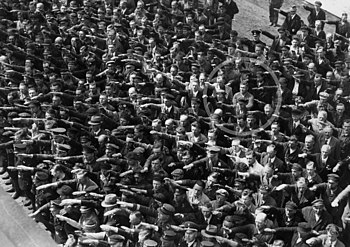This is an old revision of this page, as edited by Czrisher (talk | contribs) at 21:44, 30 October 2018 (General overhaul of text). The present address (URL) is a permanent link to this revision, which may differ significantly from the current revision.
Revision as of 21:44, 30 October 2018 by Czrisher (talk | contribs) (General overhaul of text)(diff) ← Previous revision | Latest revision (diff) | Newer revision → (diff)August Landmesser (born 24 May 1910; KIA 17 October 1944; confirmed in 1949) was a German man expelled from the Nazi Party and repeatedly prosecuted for having a relationship with Irma Eckler, a Jewish woman. He was imprisoned and eventually drafted into penal military service and killed in action in 1944.
Biography
August Landmesser was the only child of August Franz Landmesser and Wilhelmine Magdalene (née Schmidtpott). In 1931, hoping it would help him get a job, he joined the Nazi Party. In 1935, when he became engaged to Irma Eckler (a Jewish woman), he was expelled from the party. They registered to be married in Hamburg but were denied under the Nuremberg Laws. Landmesser and Eckler's first daughter, Ingrid, was born October 29, 1935.
In 1937, Landmesser and Eckler were apprehending while fleeing to Denmark. Eckler was again pregnant and Landmesser was charged and found guilty in July 1937 of "dishonoring the race" under Nazi racial laws. He argued that neither he nor Eckler knew that she was fully Jewish, and was acquitted for lack of evidence on May 27, 1938, with the warning that a repeat offense would result in a multi-year prison sentence. The couple publicly continued their relationship, and on July 15, 1938, he was arrested again and sentenced to 2.5 years in the Börgermoor concentration camp.
Eckler was detained by the Gestapo and held at the prison Fuhlsbüttel, where she gave birth to a second daughter, Irene. From there she was sent to the Oranienburg concentration camp, the Lichtenburg concentration camp for women, and then the women's concentration camp at Ravensbrück. A few letters came from Irma Eckler until January 1942. It is believed that she was taken to the Bernburg Euthanasia Centre in February 1942, where she was among the 14,000 killed; in the course of post-war documentation, in 1949 she was pronounced legally dead with a date of April 28, 1942.
Meanwhile, Landmesser was discharged from prison on January 19, 1941. He worked as a foreman for the haulage company Püst. The company had a branch at the Heinkel factory in Warnemünde. In February 1944 he was drafted into a penal battalion, the 999th Fort Infantry Battalion. He was declared killed in action after fighting in Croatia on October 17, 1944. Like Eckler, he was legally declared dead in 1949.
Their children were initially taken to the city orphanage. Ingrid was later allowed to live with her maternal grandmother while Irene went to the home of foster parents in 1941. Ingrid was also placed with foster parents after her grandmother's death in 1953.
The marriage of August Landmesser and Irma Eckler was recognized retroactively by the Senate of Hamburg in the summer of 1951, and in the autumn of that year Ingrid assumed the surname Landmesser. Irene continued to use the surname Eckler.
Refusing to Salute

In a now-famous photograph of a large gathering of workers at the Blohm+Voss shipyard in Hamburg for the June 13, 1936 launching of the naval training vessel Horst Wessel on June 13, 1936, almost everyone has raised his arm in the Nazi salute. One man, toward the back of the crowd, grimly stands with his arms crossed over his chest. Several others have also refrained from saluting, but are not so obviously defiant. In her 1996 Die Vormundschaftsakte 1935–1958: Verfolgung einer Familie wegen "Rassenschande" [de] (The Guardianship Documents 1935–1958: Persecution of a Family for "Racial Disgrace"), Irene Eckler has said the defiant man is her father, August Landmesser. The book tells the story of her family, and includes a large number of original documents from the time in question, including letters from her mother and documents from state institutions.
Another family claims the defiant man is Gustav Wegert, another metalworker at Blohm & Voss.
References
- Eckler, Irene (1996). Die Vormundschaftsakte 1935-1958: Verfolgung einer Familie wegen "Rassenschande": Dokumente und Berichte aus Hamburg. Horneburg. Retrieved 15 January 2014.
- ^ Roux, François (6 June 2013). Comprendre Hitler et les allemands. Paris, France: Éditions Max Milo. ISBN 9782315004614. Retrieved 15 January 2014.
{{cite book}}: Italic or bold markup not allowed in:|publisher=(help) - ^ Flock, Elizabeth (7 February 2012). "August Landmesser, shipyard worker in Hamburg, refused to perform Nazi salute (photo)". The Washington Post. Washington, D.C.: Washington Post Media. Retrieved 15 January 2014.
- Straße, Amanda. "Father reported missing". Fasena.de. 1&1 Internet. Retrieved 15 January 2014.
- ^ Bartrop, Paul R. (2016). Resisting the Holocaust: Upstanders, Partisans, and Survivors. ABC-CLIO. p. 152. ISBN 9781610698795.
- Simone Erpel: Zivilcourage : Schlüsselbild einer unvollendeten „Volksgemeinschaft". In: Gerhard Paul (Hrsg.): Das Jahrhundert der Bilder, Bd. 1: 1900–1949, Göttingen 2009, pp. 490–497, ISBN 978-3-89331-949-7.
- Straße, Amanda. "Verbotene Liebe | Courage". Fasena.de. 1&1 Internet. Retrieved 15 January 2014.
- Gerhard Paul, Das Jahrhundert der Bilder 1900 bis 1949, Verlag Vandenhoeck & Ruprecht 2009, Seite 494 rechte Spalte Absatz 3), as quoted in . Quote: "In the meantime another Family from Hamburg has identified the man as a relative. It should be Gustav Wegert (1890-1959) who worked as a metalworker at Blohm & Voss. As a believing Christian he generally refused the Nazi Salute. Despite his distance to the Nazi Regime Gustav Wegert did not get in the eye of the Nazi persecution administration. Portraits from Wegert and Landmesser prove in both cases great similarity with the worker on that picture. At this time it has to remain unsettled who the man in the picture is."
- "1936 - Just one refused the Nazi salute". wegert-familie.de.
- "The German Non-Saluter Myth - Beachcombing's Bizarre History Blog". 26 October 2014.
Categories: